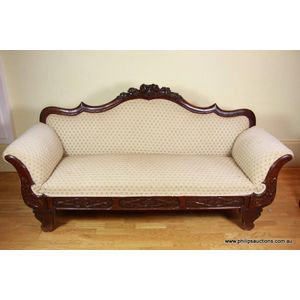Victorian Mahogany Scrolled Arm Sofa
You must be a subscriber, and be logged in to view price and dealer details.
Subscribe Now to view actual auction price for this item
When you subscribe, you have the option of setting the currency in which to display prices to $Au, $US, $NZ or Stg.
- Turned Legs - are legs which have been turned on a lathe. In use from the 16th century, turned legs on tables, chairs and cabinets became more frequent until, by the 1830s, the Georgian square or tapered leg was rarely found except in country pieces.
- Victorian Period - The Victorian period of furniture and decorative arts design covers the reign of Queen Victoria from 1837 to 1901. There was not one dominant style of furniture in the Victorian period. Designers used and modified many historical styles such as Gothic, Tudor, Elizabethan, English Rococo, Neoclassical and others, although use of some styles, such as English Rococo and Gothic tended to dominate the furniture manufacture of the period.
The Victorian period was preceded by the Regency and William IV periods, and followed by the Edwardian period, named for Edward VII (1841 ? 1910) who was King of the United Kingdom and the British Dominions and Emperor of India for the brief period from 1901 until his death in 1910. - Mahogany - Mahogany is a dense, close grained red-coloured timber from the West Indies and Central America. It was first imported into Europe in the the early 18th century and its use continued through the 19th century. It was popular for furniture making because of its strength, the wide boards available, the distinctive grain on some boards, termed flame mahogany and the rich warm colour of the timber when it was polished.. The "flame" was produced where a limb grew out from the trunk of the tree, and this timber was usually sliced into veneers for feature panels on doors, backs and cornices.
Some terms used to describe mahogany relate to the country from which it originally came, such as "Cuban" mahogany, "Honduras" mahogany etc. However unless the wood has been tested the names assigned are more a selling feature, rather than a true indication of the timber's origin. - Baluster (furniture) - An architectural term for a column in a balustrade or staircase, often defined as a "vase shape". The shape is extensively used in furniture and decorative arts.
In furniture, it is used to describe a chair or table leg turned in that form, or more usually as an inverted baluster, with the bulbous section to the top. Less commonly used to describe a chair back that has the outline of a baluster. A baluster may also be split and applied to the front of a cupboard for ornamentation.
For ceramics and silver items it is often used to describe the shape of the whole item, rather than a part.
In Georgian glassware, the shape is commonly seen in the stem of glasses. - Turning - Any part of a piece of furniture that has been turned and shaped with chisels on a lathe. Turned sections include legs, columns, feet, finials, pedestals, stretchers, spindles etc. There have been many varieties and fashions over the centuries: baluster, melon, barley-sugar, bobbin, cotton-reel, rope-twist, and so on. Split turning implies a turned section that has been cut in half lengthwise and applied to a cabinet front as a false decorative support.
- Squab - A loose cushion that fits onto the seat of a chair or settee, and can be removed. Originally the squab was constructed from horsehair, then later coconut fibre.
This item has been included into following indexes:
Visually similar items

A large Victorian chaise longue, 19th century, the chaise with a bold serpentine cresting rail, rollover arms and acanthus carved supports to a padded seat with an ogee profile seating rail, raised on large toupie feet and upholstered in mushroom pink velv

A Regency mahogany double ended chaise lounge, circa 1830, with a high low curved back, the facing frame with cut brass inlay, on four sabre legs, upholstered in Regency stripe sage silk with end cushion, 200 cm width x 66 cm depth.

A Tasmanian Colonial period cedar chaise lounge with gold silk upholstery, well carved acanthus scrolled back and arm, circa 1840, 190 cm long. Provenance: Purchased from Miss J. E. Allport, Aldridge Lodge, South Hobart, 1967.

A Victorian mahogany framed chaise longue, circa 1860s, with a scrolled showframe and a floral crest, rounded and padded arms with a relief carved seating rail and raised on square form cabriole legs; upholstered in cream floral fabric with a rose and latt
